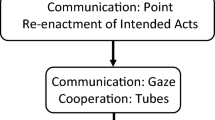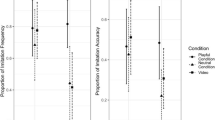Abstract
Infants were shown three modeled acts presented in sequence. Imitation of one, two, or three of the modeled acts or failure to imitate was then observed. Distress was assessed prior to and following modeling. Infants who failed to imitate at least one act displayed a high level of distress. As a control, the same infants on another day observed the random manipulation of the stimuli. Distress failed to occur when the infants failed to imitate the scattering procedure. These results are discussed in terms of the child's development of internal standards. That is, during the latter part of the second year of life, infants show considerable distress when they fail to imitate coherent modeled acts. Since distress did not occur when the model simply scattered the stimuli, we assumed that interruption of play was not an incentive for distress. Deferred imitation was noted for older but not the younger cohorts.
Similar content being viewed by others
References
Boyce, D., Knight, J., Lewis, C., Patton, F., & Richman, C. L. Self-concept and imitation.Psychological Reports 1981,49 543–546.
Goodenough, F. L.Anger in young children. Minneapolis: University of Minnesota, 1931.
Harnick, F. S. The relationship between ability level and task difficulty in producing imitation in infants.Child Development 1978,44(1), 202–212.
Kagan, J.Change and continuity in infancy. New York: Wiley, 1971.
Kagan, J. Discrepancy, temperament, and infant distress. In M. Lewis & L. A. Rosenblum (Eds.),The origins of fear. New York: Wiley, 1974.
Kagan, J. Emergent themes in human development.American Scientist 1976,64 186–196.
Kagan, J.The second year of life. Cambridge: Harvard University Press, 1981.
Kagan, J., Kearsley, R. B., & Zelazo, P. R. The emergence of initial apprehension to unfamiliar peers. In M. Lewis & L. A. Rosenblum (Eds.),Friendship and peer relations. New York: Wiley, 1975.
Kagan, J., Kearsley, R. B., & Zelazo, P. R.Infancy: Its place in human development. Cambridge: Harvard University Press, 1978.
Kotelchuck, M.The nature of the child's tie to his father. Unpublished doctoral dissertation, Harvard University, 1972.
Largo, R. H., & Howard, J. A. Developmental progression in play behavior of children between 9 and 30 months.Developmental Medical and Child Neurology 1979,21 299–310.
Leach, P.Babyhood. New York: Knopf, 1976.
Lewis, M., & Brooks, J. Infant's social perception: A constructivist view. In L. B. Cohen & P. Salapatek (Eds.),Infant perception: From sensation to cognition (Vol. 2). New York: Academic Press, 1975. Pp. 101–148.
McCall, R. B., Parke, R. D., & Kavanaugh, R. D. Imitation of live and televised models by children one to three years of age.Monographs of Social Research in Child Development, 1977,42(5, Serial No. 173).
Parton, D. A.Nonreinforced imitation as a function of response novelty. Paper presented at the meeting of the Midwestern Psychological Association, Chicago, May 1975.
Phares, E. J.Locus of control in personality. Morristown, New Jersey: General Learning Press, 1976.
Piaget, J.Play, dreams, and imitation in childhood. New York: Norton, 1951.
Richman, C. L., Bowser, S., & Price, C.Imitation: Implications for cognitive development. Paper presented at the annual meeting of the Psychonomic Society, Phoenix, November 1979.
Siebold, J. R.Response familiarity as a determinant of imitation in children. Unpublished doctoral dissertation, University of Iowa, Iowa City, 1973.
Thelen, M. H., Dollinger, S. J., & Kirkland, K. D. Imitation and response uncertainty.Journal of Genetic Psychology 1979,135 139–152.
Walters, R. H., & Amoroso, D. M. Cognitive and emotional determinants of the occurrence of imitative behavior.British Journal of Social Clinical Psychology 1967,6 174–185.
Whipple, D. V.Dynamics of development: Euthenic pediatrics. New York: McGraw-Hill, 1966.
Author information
Authors and Affiliations
Additional information
This research was supported in part by grants from MN 36491 from the National Institute of Mental Health, the U.S. Public Health Service, and Wake Forest Research and Publication funds to the first author. This paper was presented at the Meetings of the Society for Research in Child Development, San Francisco, 1979.
Rights and permissions
About this article
Cite this article
Richman, C.L., Novack, T., Price, C. et al. The consequences of failing to imitate. Motiv Emot 7, 157–167 (1983). https://doi.org/10.1007/BF00992899
Issue Date:
DOI: https://doi.org/10.1007/BF00992899




